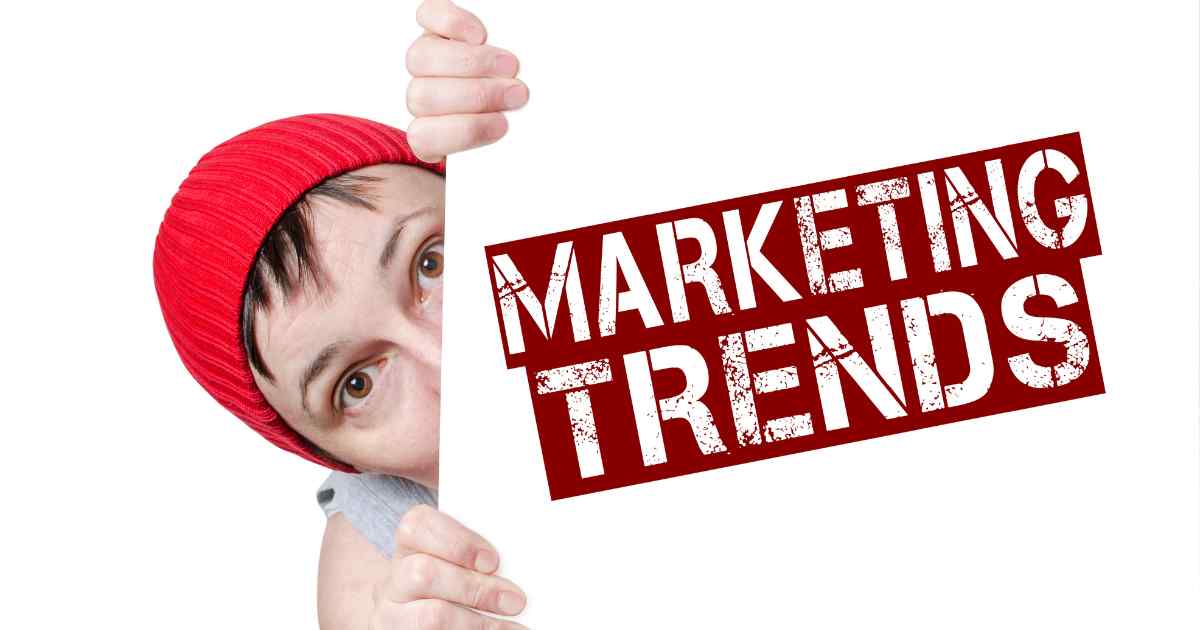Did you know 91% of B2B marketers use content marketing to reach their customers?
Content marketing isn’t just about writing blogs. It’s about creating value.
It’s crafting content that resonates, informs, and connects with your audience.
But here’s the kicker: what worked yesterday might not work today.
The digital landscape evolves. Fast.
And if you’re not keeping up with the trends, you’re falling behind.
This isn’t about hopping onto every new fad.
It’s about understanding where the market is heading and adapting.
With this blog post,let’s dive deep and ensure your brand’s voice stays relevant and heard in this ever-changing digital arena.
Overview of the Current Content Landscape
Alright, let’s take a step back and see where we came from.
Pre-digital era

Remember the days when newspapers and brochures ruled?
Before the internet, businesses thrived on word of mouth, print ads, and billboards.
Marketing was a game of massive budgets and wider reaches. It was more about who shouted the loudest.
Digital transformation
Then came the ’90s. The world went online. Websites popped up, and with Google’s birth in 1998, the SEO race began.
The game shifted from broad reach to targeted, personalized content. Businesses that mastered this new realm saw skyrocketing growth.
For instance, Amazon jumped from being a mere online bookstore to the giant it is today. All thanks to leveraging digital content.
Dominant content formats
Fast forward to today. Video content reigns supreme.
Did you know that viewers retain 95% of a message when they watch it in a video, compared to 10% when reading it in text?
Blogs still hold power, but infographics, podcasts, and webinars are making waves too.
Leading platforms
No surprises here. Facebook, with 2.9 billion monthly active users, and Google, processing 3.5 billion searches daily, still dominate.
But platforms like Instagram, TikTok, and LinkedIn are crucial players too.
They’re shaping how brands engage and converse.
Emerging Trends

Ready to look into the future?
The content world is buzzing, and new trends are emerging faster than ever. We will walk through what’s hot and what’s not, ensuring your brand stays at the forefront of the digital content scene.
Let’s dive into what’s making waves right now.
A. Video Content
Here are the types of popular video content:
· Short-form videos
Have you scrolled through TikTok or Instagram Reels lately?
If not, you’re missing out. These platforms have redefined content consumption.
Short, punchy videos, often under a minute, are captivating audiences worldwide.
Brands are now harnessing this power.
For example, Chipotle’s #GuacDance challenge on TikTok garnered a whopping 250,000 video submissions!
It’s not just about virality. It’s about engagement.
· Live streaming
Think of it as a real-time connection with your audience.
Platforms like Facebook Live and Twitch are booming. Why?
They offer real-time interaction, fostering deeper brand connections.
A fun fact: In 2020, live streaming grew by 93% in watch time year-over-year!
· Video SEO
YouTube’s the second-largest search engine, right after Google.
If you’re not optimizing your videos, you’re leaving views on the table.
Proper titles, descriptions, and tags are no longer optional. They’re essential.
B. Voice Search & Smart Speakers

Besides video, voice search has grown incredibly in the recent years.
· Voice search optimization
“Hey, Siri! How can brands rank on voice search?”
As more people ask questions aloud, optimizing for voice search has become pivotal.
By 2024, the global voice-based smart speaker market is predicted to be worth over $30 billion!
· Podcasting
It’s radio 2.0. With over 2 million active podcasts and counting, this medium’s explosive growth is undeniable.
Brands like Trader Joe’s even have their own shows.
Podcasting offers deep dives into subjects, positioning brands as thought leaders.
C. Augmented Reality (AR) and Virtual Reality (VR)
They are the new entrants but expanding their horizons exponentially:
· AR in content marketing
Ever tried those Instagram filters? That’s AR in action.
Brands are now using AR for virtual try-ons, interactive ads, and more.
It provides an immersive experience, bridging the gap between digital and reality.
· VR experiences
Imagine walking through a hotel before booking a room.
With VR, it’s possible. Brands are creating 360-degree tours, product demos, and immersive experiences.
By 2022, the VR market’s projected to hit $209.2 billion. It’s not sci-fi. It’s the future of content.
The key takeaway? Content marketing’s evolving. Adapt, innovate, and ride these trends. Your audience awaits.
D. Artificial Intelligence

With the growing popularity of artificial intelligence
· Chatbots
Late-night website visit and have a question? Chatbots are there.
By 2025, the global chatbot market is expected to reach over $10 billion.
The beauty? They’re available 24/7, providing instant customer service. And guess what?
People love them.
About 67% of consumers worldwide used a chatbot for customer support in the past year.
· Personalization using AI
Ever wondered how Netflix knows what you want to watch? AI.
Brands are using AI for hyper-personalized content recommendations, driving user engagement.
Personalized emails, for instance, show a 41% higher click-through rate than generic ones.
It’s no longer about mass messaging; it’s about the right message for the right person at the right time.
E. Ephemeral Content
Stories on various platforms:
Snapchat started it, but Instagram, Facebook, and even LinkedIn jumped on the bandwagon.
‘Stories’ are everywhere.
They’re short-lived (24 hours), but their impact isn’t.
Brands are leveraging stories for flash sales, behind-the-scenes glimpses, and more.
And it’s working.
1 in 4 Millennials and Gen Z-ers look for Stories of the products they want to buy.
Benefits of Ephemeral Content
Why the buzz around content that lasts only a day?
It’s the FOMO (Fear Of Missing Out). Ephemeral content is fresh, engaging, and drives instant action. It’s raw, real, and resonates.
F. Sustainability and Social Responsibility

Sustainability is the key to differentiate your brand today.
· Environmentally friendly content
Brands are going green, not just in operations but in messaging too.
Showcasing sustainable practices, eco-friendly products, or just educating about the environment — it all matters.
Did you know?
66% of consumers are willing to spend more on a product if it comes from a sustainable brand.
· Socially responsible messaging
In today’s age, silence is not golden.
Brands are taking stands, addressing social issues, and aligning with causes.
From racial equality to mental health, content is now a platform for change.
The result? Deeper, meaningful connections with audiences.
Innovation is at the forefront of content marketing.
But remember, it’s not about jumping onto every trend.
It’s about understanding your audience, knowing what resonates, and delivering value. Stay ahead, stay relevant.
Detailed Analysis of Selected Trends

Understanding trends is just half the battle. Let’s deep-dive into the nitty-gritty — the real impact and the stories behind them.
A. Benefits and Challenges
Pros and cons for marketers:
Pros:
- Greater Engagement: Leveraging top trends means better resonance with audiences.
- Data Collection: AI and chatbots allow efficient data collection for refined strategies.
- Enhanced Reach: Platforms like Instagram and TikTok give a broader, younger audience reach.
Cons:
- Resource Intensive: Trends like AR and VR require significant investment.
- Fast-paced Evolution: Trends change quickly, demanding constant adaptability.
- Saturation: Popular platforms can become saturated, making it harder to stand out.
Pros and cons for consumers:
Pros:
- Personalized Experiences: AI-driven personalization means more relevant content.
- Interactivity: AR, VR, and chatbots provide a more immersive experience.
- Instant Gratification: Chatbots and live streams offer real-time solutions and entertainment.
Cons:
- Overwhelm: The sheer volume of content can lead to information overload.
- Privacy Concerns: AI-driven personalization can raise data privacy issues.
- Short-lived Content: Ephemeral content can be frustrating if missed.
B. Case Studies
Here are some of the case studies reflecting the content marketing trends:
· Nike’s AR Shopping Experience
Remember when Nike introduced its AR feature to help customers find the perfect shoe size?
A brilliant blend of tech and marketing. It reduced product returns and skyrocketed customer satisfaction.
· Spotify’s AI-Driven Playlists
Ever wonder how “Discover Weekly” hits the mark? Spotify uses AI to analyze user behavior, creating eerily accurate song recommendations.
Result? A loyal, hooked user base.
C. Lessons learned from failures

Here are some Ad campaigns that set as mark for
· Pepsi’s Misguided Ad
In an attempt to resonate, Pepsi’s 2017 ad with Kendall Jenner missed the mark. It was seen as a trivialization of serious social issues.
The lesson? Social messaging in content marketing requires sensitivity and authenticity.
· Chatbot Mishaps
Microsoft’s Tay is a classic example. Within hours of its release, it started posting inappropriate tweets.
Why? It mimicked users without adequate filters. The takeaway?
Ensure your AI tools are robust and foolproof.
Real success in content marketing comes from a blend of trend adoption and understanding their depth.
It’s not just about the ‘what’ but also the ‘why’ and ‘how’. Dive deep, and the results will follow.
Tools and Platforms

With the evolving content landscape, the right tools can be the difference between good and great.
Let’s unpack some of the must-haves for every content marketer.
A. Content Creation Tools
Here is the list of content creation tools that helps you to keep pace with content marketing trends:
Graphic design tools
- Canva: User-friendly with a vast library of templates. Perfect for beginners to pros.
- Adobe Creative Cloud: Comprehensive suite, including Photoshop and Illustrator, for those serious about design.
- Figma: Collaborative interface design tool, ideal for real-time collaboration.
Video editing tools
- Adobe Premiere Pro: Professional-grade video editing software used by many industry leaders.
- Final Cut Pro: Apple’s advanced video editing tool, renowned for its intuitive interface.
- Filmora: An accessible option for beginners, with a straightforward UI and a host of built-in features.
B. Content Management Systems (CMS)

Here are the popular CMS that elevates your online presence:
Popular CMS platforms
- WordPress: Powers 40% of the web. Known for its versatility and extensive plugin ecosystem.
- Squarespace: Drag-and-drop interface, favored by many for its sleek designs.
- Wix: User-friendly with many customizable templates. Suitable for businesses of all sizes.
Features to look for in a CMS
- Intuitive Editor: For easy content uploading and modification.
- SEO-Friendly: Essential for organic search visibility.
- Responsive Design: Ensures your content looks great on all devices.
- Integration Capabilities: For tools like email marketing software or analytics platforms.
- Robust Security: To protect your site and content from potential threats.
C. Analytics and SEO Tools
Tools crucial for analysis of content performance:
Tools for SEO optimization:
- SEMrush: Comprehensive SEO tool offering keyword research, site audit, and competitive analysis.
- Moz Pro: Known for its domain authority metric and on-page optimization insights.
- Ahrefs: A favorite for backlink analysis and keyword tracking.
Content performance analytics:
- Google Analytics: The gold standard for website analytics. Understand your audience, traffic sources, and content performance.
- Hotjar: Provides heatmaps and user session recordings to understand visitor behavior.
- HubSpot: An all-in-one platform with tools for content marketing, lead generation, and analytics.
Equip yourself with these tools and platforms, and you’re well on your way to mastering the dynamic world of content marketing.
Remember, it’s not just about creating content, but crafting it effectively, managing it efficiently, and measuring its impact precisely.
Strategy and Implementation

Success in content marketing doesn’t just happen. It’s a result of meticulous planning, precise execution, and ongoing assessment.
Here’s a roadmap to navigate through this process.
A. Developing a Content Marketing Strategy
Things to consider before developing content marketing strategy:
Setting goals:
- Awareness: Boosting brand visibility and reach.
- Engagement: Engaging and nurturing your audience.
- Conversion: Turning potential customers into actual customers.
- Retention: Keeping existing customers loyal and engaged.
Target audience analysis:
- Demographics: Understand age, gender, occupation, and more.
- Psychographics: Dive into interests, values, and behaviors.
- Pain Points: Identify challenges your audience faces that your content (and products) can solve.
- Consumption Patterns: Determine when, where, and how your audience consumes content.
B. Implementation
Once you devise a strategy, the next step is implementation:
Content calendar:
- Plan Ahead: Schedule content weeks or months in advance to ensure consistency.
- Diversify: Mix content types and topics to keep your audience engaged.
- Revisit: Periodically adjust based on performance analytics and emerging trends.
Budget allocation:
- Content Creation: Allocate funds for creating high-quality content, whether in-house or outsourced.
- Promotion: Designate a budget for paid promotions, ads, and boosting content.
- Tools & Platforms: Invest in essential tools for content creation, management, and analytics.
C. Measurement
It is important to access the campaigns to understand if they are worth to continue:
KPIs (Key Performance Indicators):
- Traffic Metrics: Monitor website visitors, page views, and average session duration.
- Engagement Metrics: Track likes, shares, comments, and average time spent on content.
- Conversion Metrics: Measure lead generation, subscriber count, and conversion rates.
- Retention Metrics: Monitor churn rate, customer lifetime value, and repeat visits.
ROI (Return on Investment) measurement:
- Direct Sales: Measure sales resulting from specific content pieces or campaigns.
- Lead Quality: Assess the quality of leads generated from content efforts.
- Cost Savings: Compare costs of content marketing to traditional marketing methods.
- Brand Value: While harder to quantify, gauge improvements in brand perception and authority.
Crafting an effective content marketing strategy is a cycle.
Set your course, implement with precision, measure your success, and then refine.
It’s not a one-time task but an ongoing process, always evolving with the landscape.
Stay agile, keep learning, and your content will shine.
Future Prospects

The digital landscape is always in flux, driven by technology, user behavior, and global events.
As content marketers, it’s imperative to not just react to changes, but anticipate and adapt to them.
So, let’s gaze into the crystal ball.
A. Predictions for the Future
- Rise of Immersive Content: As AR and VR technologies become more accessible, immersive content experiences will move from novelty to expectation.
- AI-driven Personalization: As AI matures, expect hyper-personalized content delivery, where content is tailored in real-time based on user behavior, preferences, and predictive analytics.
- Voice and Visual Search: Text-based search won’t disappear, but more people will use voice commands or image searches, necessitating a change in SEO strategies.
- Sustainability and Social Advocacy: Brands will be expected to have a stand, not just on their industry, but on global issues. Content will reflect this greater social consciousness.
- Decentralization of Content: With the rise of blockchain and similar technologies, we might see a move away from central platforms to more decentralized content sharing and monetization methods.
B. Preparing for the Future
Invest in Learning: Regularly update your skills.
Whether it’s a new tool, platform, or content strategy, be a perpetual student.
- Diversify Content Types: Don’t put all your eggs in one basket. If you’ve focused solely on blog posts, start exploring video, podcasts, or interactive content.
- Data Security: With greater personalization comes greater responsibility. Ensure your data collection and storage methods are secure and compliant with emerging regulations.
- Collaborate: Build partnerships. Collaborative content projects, whether with other brands or influencers, can help you reach new audiences and bring fresh perspectives.
- Stay Agile: The future is unpredictable. Have a strategy, but be willing to pivot when needed. Regularly review and adjust your content strategy based on performance data and emerging trends.
The future of content marketing is bright, filled with possibilities limited only by our imagination and willingness to adapt. Embrace change, stay informed, and most importantly, remain focused on delivering value to your audience. That’s the true north that will guide you through whatever the future holds.
Final Thoughts

The realm of content marketing is as thrilling as it is challenging.
As platforms evolve, technologies advance, and user preferences shift, one principle remains constant: the need to deliver genuine value to our audiences.
It’s not about hopping on every trend but discerning which ones align with our brand and our audience’s desires.
Remember, while tools and trends play their part, the heart of content marketing lies in the stories we tell and the connections we forge.
The future belongs to those who not only understand the ‘how’ but deeply resonate with the ‘why’ of content creation.









